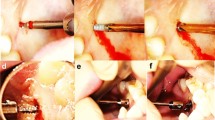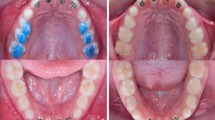Abstract
Data sources
Medline via PubMed, Scopus and Web of Science databases were searched from January 2003 to March 2015 limited to human studies published in English. Manual searches for the relevant reference lists and a grey literature search via Google Scholar were also conducted.
Study selection
Prospective and retrospective studies about the stability of miniscrew implants (MIs) used for orthodontic anchorage into the posterior buccal region were considered. Two review authors independently assessed titles and abstracts, and evaluated full manuscripts for the meta-analysis.
Data extraction and synthesis
The outcome measure was the success rate of MIs which had to be explicitly reported in order to enable its computation as odds ratios with regards to patient factors (age (years), < 20 vs. ≥ 20; sex, male vs. female; jaw of insertion, maxilla vs. mandible) and MI factors (length, < 8 mm vs. ≥ 1.4 mm; diameter, ≤ 1.4 mm vs. > 1.4 mm). The quality of the studies was assessed using the Newcastle-Ottawa Scale (NOS). The meta-analysis was expressed as combined OR and heterogeneity was evaluated (Cochran Q and I2). Subgroup meta-analysis was conducted based on study design, study quality and MIs sample size. Publication bias analysis (Begg's and Eggar's tests) and sensitivity analysis were performed.
Results
Seventeen non-randomised studies, five prospective and 12 retrospective, were included. Significantly higher success rates were observed for the maxillary MIs (14 studies odds ratio (OR), 2.32; 95% CI, 1.81-4.08), older patients (six studies OR, 1.59; 95% CI, 1.14-2.22), and for longer MIs (four studies OR, 0.56 (1/0.46= 2.17); 95% CI, 0.26-0.20) and MIs with larger diameter (four studies OR, 0.62 (1/0.62= 1.61); 95% CI, 0.40-0.97), whereas there was no difference observed between male and female patients (13 studies OR, 1.18; 95% CI, 0.92-1.51). All subgroups acquired homogeneity except for the components of study design regarding the jaw of insertion.
Conclusions
The results of this meta-analysis based on non-randomised clinical studies showed that jaw of insertion, age, MI length and MI diameter are critical risk factors to the success of MIs, whereas sex was not influential.
Source of Funding
The Basic Science Research Program of the National Research Foundation of Korea was stated as the source of funding.
Similar content being viewed by others
Log in or create a free account to read this content
Gain free access to this article, as well as selected content from this journal and more on nature.com
or
References
Suzuki EY, Suzuki B . Placement and removal torque values of orthodontic miniscrew implants. Am J Orthod Dentofacial Orthop 2011; 139: 669–678.
Uman LS . Systematic reviews and meta-analyses. J Can Acad Child Adolesc Psychiatry 2011; 20: 57–59.
Higgins JPT, Green S . Cochrane handbook for systematic reviews of interventions Wiley-Blackwell: Chichester, 2014.
Moher D, Liberati A, Tetzlaff J . Altman DG ; PRISMA Group. Preferred reporting items for systematic reviews and meta-analyses: the PRISMA statement. J Clin Epidemiol 2009; 62: 1006–1012.
Morrison A, Polisena J, Husereau D, et al. The effect of English-language restriction on systematic review-based meta-analyses: a systematic review of empirical studies. Int J Technol Assess Health Care 2012; 28: 138–144.
Melander H, Ahlqvist-Rastad J, Meijer G, Beermann B . Evidence b(i)ased medicine--selective reporting from studies sponsored by pharmaceutical industry: review of studies in new drug applications. BMJ 2003; 326: 1171–1173.
Jüni P, Holenstein F, Sterne J, Bartlett C, Egger M . Direction and impact of language bias in meta-analyses of controlled trials: empirical study. Int J Epidemiol 2002; 31: 115–123.
Fan H, Song F . An assessment of randomized controlled trials (RCTs) for non-communicable diseases (NCDs): more and higher quality research is required in less developed countries. Sci Rep 2015; 5: 13221.
Wells GA, Shea B, O'Connell D, et al. The Newcastle-Ottawa Scale (NOS) for assessing the quality of non-randomized studies in meta-analyses. [cited 2016 June] Available from: http://www.ohri.ca/programs/clinical_epidemiology/oxford.htm
Stang A . Critical evaluation of the Newcastle-Ottawa scale for the assessment of the quality of nonrandomized studies in meta-analyses. Eur J Epidemiol 2010; 25: 603–605.
Cornelis MA, Scheffler NR, De Clerck HJ, Tulloch JF, Behets CN . Systematic review of the experimental use of temporary skeletal anchorage devices in orthodontics. Am J Orthod Dentofacial Orthop 2007; 131: S52–58.
Chen Y, Kyung HM, Zhao WT, Yu WJ . Critical factors for the success of orthodontic mini-implants: a systematic review. Am J Orthod Dentofacial Orthop 2009; 135: 284–291.
Reynders R, Ronchi L, Bipat S . Mini-implants in orthodontics: a systematic review of the literature. Am J Orthod Dentofacial Orthop 2009; 135: 564. e1–19; discussion 564–565.
Crismani AG, Bertl MH, Celar AG, Bantleon HP, Burstone CJ . Miniscrews in orthodontic treatment: review and analysis of published clinical trials. Am J Orthod Dentofacial Orthop 2010; 137: 108–113.
Schätzle M, Männchen R, Zwahlen M, Lang NP . Survival and failure rates of orthodontic temporary anchorage devices: a systematic review. Clin Oral Implants Res 2009; 20: 1351–1359.
Papageorgiou SN, Zogakis IP, Papadopoulos MA . Failure rates and associated risk factors of orthodontic miniscrew implants: a meta-analysis. Am J Orthod Dentofacial Orthop 2012; 142: 577–595. e577.
Dalessandri D, Salgarello S, Dalessandri M, et al. Determinants for success rates of temporary anchorage devices in orthodontics: a meta-analysis (n > 50). Eur J Orthod 2014; 36: 303–313.
Richards D . Keeping up to date. Evid Based Dent 2015; 16: 98.
Author information
Authors and Affiliations
Additional information
Address for correspondence: Prof. Hoi-Jeong Lim. Department of Orthodontics, School of Dentistry, Dental Science Research Institute, Chonnam National University, 33 Yongbong-ro, Buk-gu, Gwangju 61186, Korea. E-mail: hjlim@jnu.ac.kr
Hong SB, Kusnoto B, Kim EJ, BeGole EA, Hwang HS, Lim HJ. Prognostic factors associated with the success rates of posterior orthodontic miniscrew implants: A subgroup meta-analysis. Korean J Orthod 2016; 46: 111–126. doi: 10.4041/kjod.2016.46.2.111.
Rights and permissions
About this article
Cite this article
Afrashtehfar, K. Patient and miniscrew implant factors influence the success of orthodontic miniscrew implants. Evid Based Dent 17, 109–110 (2016). https://doi.org/10.1038/sj.ebd.6401202
Published:
Issue date:
DOI: https://doi.org/10.1038/sj.ebd.6401202



